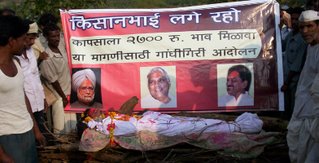
Killing fields grow hope
Jaideep Hardikar aturday, February 03, 2007 21:31
.While tens of farmers continue to take their own lives in Vidarbha, hope hasn't died completely for thousands of others. Resilient in their battle, they are trying to take baby steps to mitigate the agrarian distress collectively. "These are refreshingly welcome people's initiatives. Hoping for policy changes will take us nowhere," says Kishor Tiwari, convenor of the Vidarbha Jan Andolan Samiti (VJAS).
A DNA Analysis
http://www.dnaindia.com/report.asp?NewsID=1077821
NAGPUR: Not once did Shobha Gajbe, 35, think that she could cook her way out of a back-breaking debt, one that made her cotton farmer husband a cynic. But it's the mid-day meals that she cooks for school children in Keslapur, a village around 60 kilometres from Nagpur, that is helping Gajbe melt her family's debt mountain. In the cotton country of Vidarbha, where one farmer, on an average, commits suicide every six to eight hours unable to bear the burden of debt and failed crops, there is a silent revolution brought on by women.
From running video parlours in villages to goat farming, managing bamboo plantations to cooking midday meals for school students and to running small cottage industries, the women's collectives in the region are taking up ventures that are redefining the way business is conducted in these parts. But how are they doing it?
A minimum ten women come together and form a group. They pool in little money every day and after raising a corpus approach a bank or financial institution for loan depending upon their need and project. Members also borrow money from the group's savings at minimum interest rate from time to time to meet their needs and demands. In Yavatmal, where hundreds of farmers have taken their own lives, a few such women's collectives are beginning to farm together by leasing land; rejecting the capital-intensive chemical farming, and adopting low-cost organic farming. They have reaped not just a better harvest this year, but decent dividends too.
The power of one
But it isn't just the women who are discovering the benefits of collective bargaining. Marginal farmer Vijay Pote, 39, from Pisapur village in Wardha was till recently at his wits end trying to figure out how to even out the uncertainties of the agricultural market.
Like tens of thousands of farmers in Vidarbha, Pisapur farmers made losses year after year and had grown desperate till they took the lead from the farmers of Amravati, where over 4000 joined hands to collectively farm and bargain with the traders.
Pisapur farmers went for the same collective farming model and have managed to cut down their cost of production dramatically. Pote and 80-plus members first bargained with inputs dealers as they went for a joint purchase of seeds and other inputs. They got the inputs prices reduced.
Then, they shifted to organic farming to reduce the use to pesticides. That saved a big component of production cost. Finally, after repeating a good harvest of soyabean, they struck a collective deal with the traders and got better prices. In short, profit margins rose by about 20 to 30 per cent. "We have found a way, and we think we can work wonders through our collective," says Pote. "We are not alone in our struggle now."
Going back to basics
For Rajendra Pande and some 20-odd farmers in Chilli Ijara village in Mahagaon tehsil of Yavatmal district, the refusal by banks to give them credit came as a boon in disguise.
"We all decided that we would go to our basics and cultivate Jowar. And for the first time in recent year the harvest has given us profits," says Pande. "I sowed Jowar on all my ten acres since I had no money to grow cotton or soybean. I spent Rs1400 per acre, and on an average got 17 quintals of yield. I made a profit of Rs 10,000 an acre." Pande and his other friends say they won't grow cotton again.
But for thousands of others still sticking to cotton, there's a way out. Close to 500 villages are demonstrating in Vidarbha that the Insecticide Resistance Management (IRM), a technology-initiative of the Central Institute for Cotton Research (CICR), is an option. "If the farmers sow desi varieties of cotton the use of chemicals will be more than halved, and thus the production cost will be reduced," says CICR Director M Khadi.
Moreover, the foliage or the plant waste can be converted into charcoal, a successful initiative funded by the State Bank of India. "A cotton farmer can earn additional Rs1000 for an acre of his plant wastes," says social worker Atul Sharma.
While tens of farmers continue to take their own lives in Vidarbha, hope hasn't died completely for thousands of others. Resilient in their battle, they are trying to take baby steps to mitigate the agrarian distress collectively.
"These are refreshingly welcome people's initiatives. Hoping for policy changes will take us nowhere," says Kishor Tiwari, convenor of the Vidarbha Jan Andolan Samiti (VJAS).
1 comment:
Hi
Thank you for your blog. Our new documentary, 'How to Save the World,' was shot in India and deals directly with all the issues you raise. It explores food sovereignty and bio-colonialism and provides positive examples of organic and bio-dynamic farming.
Please visit www.howtosavetheworld.co.nz
Post a Comment